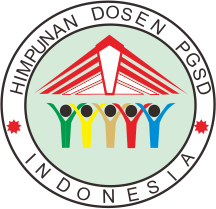UPAYA PENINGKATAN PEMBELAJARAN PERMAINAN BOLA BASKET MELALUI METODE PENDEKATAN TAKTIK PADA SISWA KELAS VIII C SMP NEGERI 2 PANDAK BANTUL
DOI:
https://doi.org/10.30595/dinamika.v6i1.897Keywords:
Basketball Learning, Tactics Approach MethodAbstract
This study aims to improve basketball learning through the tactics approach method among Grade VIII C students of SMP Negeri 2 Pandak Bantul. This was a classroom action research (CAR) study consisting two cycles. The research subjects were 36 Grade VIII C students of SMP Negeri 2 Pandak, Bantul. The data were collected through: (1) observations on the basketball learning outcomes using the tactics approach method, (2) classroom observations on the teacher, (3) observations on classroom situations, (4) observations on students’ behaviors, and (5) a cognitive test. The results of the study revealed that there was an improvement in basketball learning through the tactics approach method among Grade VIII C students of SMP Negeri 2 Pandak, Bantul. Basketball learning through the tactics approach method among Grade VIII C in 2 cycles improved the process skills in playing basketball game with the tactics approach. Based on the assessment at the end of Cycle I, the students’ average score was 72.8. At the end of Cycle II, their average score improved to 78.0, so it was above the Minimum Mastery Criterion (MMC), i.e. 71. Meanwhile, the number of students who attained MMC in Cycle I was 17 (47%), and in Cycle II it became 33 (96%); this was above the class mastery, i.e. 75%. The class mastery from the cognitive aspect could be explained as follows: from the pretest results, the mastery was 16.67%, in Cycle I it was 91.67%, and in Cycle II it was 100%. The recapitulation from the observations on the students’ learning behaviors in Cycle I was 2.8, improving to 3.8 in Cycle II; that from the observations of teachers in Cycle I was 2.9, improving to 3.7 in Cycle II; and the class situation in Cycle I was 2.7, improving to 3.7 in Cycle IIReferences
Agus Mukholid. (2004). Pendidikan Jasmani. Surakarta: Yudhistira.
A Full Report. (2008). Physical education matters. Tersedia. http://www.calendow.org/uploadedFiles/Publications/By_Topic/Disparities/Obesity_and_Diabetes/PE%20Matters%20Long%20VersionFINAL.pdf. Diunduh tanggal 19 Januari 2013.
Anin Rukmana (2008) Pembelajaran Pendidikan Jasmani di Sekolah Dasar. Tersedia.http://file.upi.edu/Direktori/JURNAL/PENDIDIKAN_DASAR/Nomor_9April_2008/Pembelajaran_Pendidikan_Jasmani_di_Sekolah_Dasar.pdf. Diunduh tanggal 14 Januari 2013
Anonim. (2011). Hakekat Pendidikan Jasmani. Tersedia http://blog.tp.ac.id/pdf/tag/artikel-makalah-hakekat-pendidikan-jasmani.pdf. Diunduh tanggal 22 Februari 2013.
Ayi Suherman (2009) Pengembangan Model Pembelajaran Outdoor Education Pendidikan Jasmani Berbasis Kompetensi Di Sekolah Dasar. Tersedia http://jurnal.upi.edu/file/ayi.pdf. Diunduh tanggal 16 Januari 2013.
BSNP. (2006). Standar Isi Untuk Satuan Pendidikan Dasar Dan Menengah. Jakarta
Das, S., Dewhurst, Y., Gray, D. (2011). A teacher’s repertoire: developing creative pedagogies. International Journal of Education & the Arts, 12(15). Retrieved [date] from ttp://www.ijea.org/v12n15/. Diunduh tanggal 26 Januari 2013.
Dedy Sumiyarsono. (2002). Keterampilan Bola Basket. Surakarta: Yudhistira.
Griffin, Linda L. (2005). Teaching games for understanding. United States of America: Human Kinetics.
Jacqueline Leta, Suely Rosa. (2012). Trends in scientific publications in physical education: a multifaceted field? Tersedia.http://jcom.sissa.it/archive/ 11/01/Jcom1101(2012)A03/Jcom1101(2012)A03.pdf. Diunduh tanggal 10 Maret 2013.
Masurier Guy Le. (2006). Top 10 Reasons for quality physical education. Tersedia.http://www.aahperd.org/naspe/publications/teachingtools/upload/top10reasonsforqualitype.pdf. Diunduh tanggal 18 Januari 2013.
Metzler, Michael W. (2000). Instructional Models for Physical Education. United States of America: Allyn and Bacon.
Mitchell, Stephen A., Oslin, Judith L., & Griffin, Linda L. (2006). Teaching sport concepts and skills. United States of America: Human Kinetics.
Muhajir. (2007). Pendidikan Jasmani Olahraga Dan Kesehatan SMA Kelas X. Bandung: Erlangga.
Nuril Ahmadi. (2007). Permainan Bola Basket. Solo: Era Intermedia.
Oliver Jon. (2007). Basketball Fundamentals. Canada: Human Kinetics.
Permen Diknas RI Nomor 23. (2006). Standar Kompetensi Kelulusan Untuk Satuan Pendidikan Dasar dan Menengah. Jakarta: Mendiknas.
Rink Judith E.. (2010). Teaching physical education for learning. New York. The Mc Graw Hill Companies.
Rochiati Wiriatmaja. (2006). Metode Penelitian Tindakan Kelas. Bandung: PT. Remaja Rosdakarya.
Sabaruddin Yunis Bangun (2008) Analisis Tujuan Materi Pelajaran dan Metode Pembelajaran Dalam Pendidikan Jasmani. tersedia http://online-journal.unja.ac.id/index.php/csp/article/download/706/634. Diunduh tanggal 14 Januari 2013.
Simson Kevin. (2009). Did I just share too much information?†Results of a National Survey on Faculty Self Disclosure. Tersedia http://www.isetl.org/ijtlhe/pdf/IJTLHE20(2).pdf. Diunduh tanggal 26 Januari 2013.
Suharsimi Arikunto. (2007). Penelitian Tindakan Kelas. Jakarta: PT BumiAksara.
Suharsimi Arikunto dkk. (2006). Penelitian tindakan kelas. Jakarta: Bumi Aksara.
Syamsu Yusuf. (2004). Psikologi Perkembangan Anak Dan Remaja. Bandung. PT Remaja Rodaskarya.
Tim. (2007). Panduan KKN-PPL 2007 UNY. Yogyakarta: UNY.
Through Grade Twelve. (2010). Physical education model content standards for california public schools kindergarten. Tersedia http://www.cde.ca.gov/be/st/ss/documents/pestandards.pdf. Diunduh tanggal 25 Januari 2013.
U.S. Department of Health and Human Services. (2010). The association between school-based physical activity, including physical education, and academic performance. Tersedia http://www.cdc.gov/healthyyouth/health_and_academics/pdf/pa-pe_paper.pdf. Diunduh tanggal 10 Maret 2013.
Downloads
How to Cite
Issue
Section
License
Authors who publish with this journal agree to the following terms:
Authors retain copyright and grant the journal right of first publication with the work simultaneously licensed under a Creative Commons Attribution License that allows others to share the work with an acknowledgement of the work's authorship and initial publication in this journal.
Authors are able to enter into separate, additional contractual arrangements for the non-exclusive distribution of the journal's published version of the work (e.g., post it to an institutional repository or publish it in a book), with an acknowledgement of its initial publication in this journal.
Authors are permitted and encouraged to post their work online (e.g., in institutional repositories or on their website) prior to and during the submission process, as it can lead to productive exchanges, as well as earlier and greater citation of published work (See The Effect of Open Access).

Dinamika Jurnal Ilmiah Pendidikan Dasar is licensed under a Creative Commons Attribution 4.0 International License.













